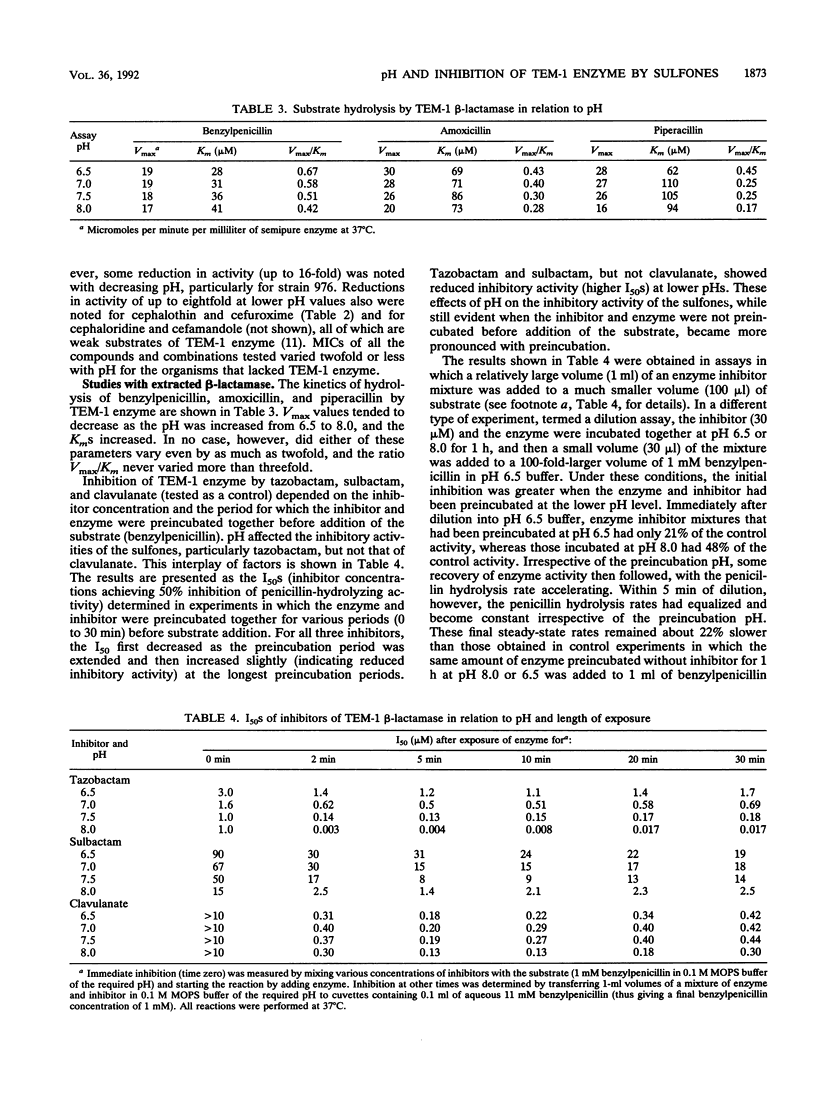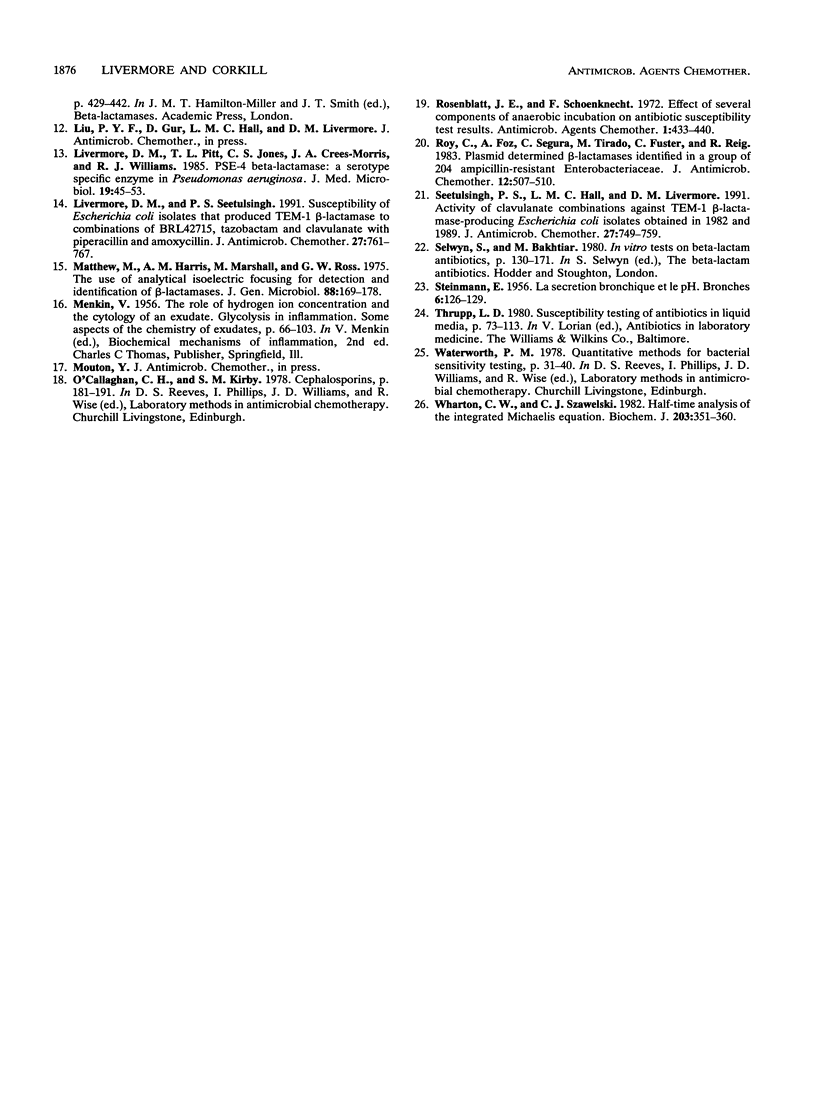Abstract
Incubation in 5% CO2 reduced the inhibition zones of piperacillin-tazobactam (75/10 micrograms) disks for Escherichia coli strains with TEM-1, TEM-2, and SHV-1 beta-lactamases. Similarly, MICs of piperacillin-tazobactam and other penicillin-sulfone combinations for TEM producers were up to 500-fold higher at pH 6.5 than at pH 8.0. This effect was greatest for organisms with high levels of enzyme activity. CO2 and mild acidity did not affect the susceptibility of beta-lactamase-negative strains to penicillin-sulfone combinations, and the effects of these conditions were variable for organisms with beta-lactamases other than TEM-1, TEM-2, and SHV-1. These last observations discounted acid-mediated inactivation of piperacillin or tazobactam. MICs of amoxicillin or piperacillin alone or with clavulanate for TEM and SHV producers were affected only less than or equal to 16-fold by 5% CO2 or acidity, indicating that the greater effects seen with the penicillin-sulfone combinations depended on the behavior of the sulfones and not on that of the penicillins. This pH effect was studied in detail for TEM-1 enzyme. Inhibition of this enzyme by sulfones but not clavulanate varied grossly with pH, with 50% inhibitory concentrations of tazobactam and sulbactam up to 300-fold higher at pH 6.5 than at 8.0. By contrast, the hydrolytic activity of TEM-1 enzyme for substrates and its level of production varied threefold or less between pH 6.5 and pH 8.0. Increased inhibition at pH 8.0 reflected sequestration of the enzyme into a secondary noncovalent complex rather than increased irreversible inactivation.
Full text
PDF






Selected References
These references are in PubMed. This may not be the complete list of references from this article.
- Aronoff S. C., Jacobs M. R., Johenning S., Yamabe S. Comparative activities of the beta-lactamase inhibitors YTR 830, sodium clavulanate, and sulbactam combined with amoxicillin or ampicillin. Antimicrob Agents Chemother. 1984 Oct;26(4):580–582. doi: 10.1128/aac.26.4.580. [DOI] [PMC free article] [PubMed] [Google Scholar]
- Bodem C. R., Lampton L. M., Miller D. P., Tarka E. F., Everett E. D. Endobronchial pH. Relevance of aminoglycoside activity in gram-negative bacillary pneumonia. Am Rev Respir Dis. 1983 Jan;127(1):39–41. doi: 10.1164/arrd.1983.127.1.39. [DOI] [PubMed] [Google Scholar]
- Datta N., Hedges R. W. Trimethoprim resistance conferred by W plasmids in Enterobacteriaceae. J Gen Microbiol. 1972 Sep;72(2):349–355. doi: 10.1099/00221287-72-2-349. [DOI] [PubMed] [Google Scholar]
- Fisher J., Belasco J. G., Khosla S., Knowles J. R. beta-Lactamase proceeds via an acyl-enzyme intermediate. Interaction of the Escherichia coli RTEM enzyme with cefoxitin. Biochemistry. 1980 Jun 24;19(13):2895–2901. doi: 10.1021/bi00554a012. [DOI] [PubMed] [Google Scholar]
- Fisher J., Charnas R. L., Knowles J. R. Kinetic studies on the inactivation of Escherichia coli RTEM beta-lactamase by clavulanic acid. Biochemistry. 1978 May 30;17(11):2180–2184. doi: 10.1021/bi00604a024. [DOI] [PubMed] [Google Scholar]
- Jacoby G. A., Medeiros A. A. More extended-spectrum beta-lactamases. Antimicrob Agents Chemother. 1991 Sep;35(9):1697–1704. doi: 10.1128/aac.35.9.1697. [DOI] [PMC free article] [PubMed] [Google Scholar]
- Jacoby G. A. Properties of R plasmids determining gentamicin resistance by acetylation in Pseudomonas aeruginosa. Antimicrob Agents Chemother. 1974 Sep;6(3):239–252. doi: 10.1128/aac.6.3.239. [DOI] [PMC free article] [PubMed] [Google Scholar]
- Kempers J., MacLaren D. M. Piperacillin/tazobactam and ticarcillin/clavulanic acid against resistant Enterobacteriaceae. J Antimicrob Chemother. 1990 Oct;26(4):598–599. doi: 10.1093/jac/26.4.598. [DOI] [PubMed] [Google Scholar]
- Livermore D. M., Pitt T. L., Jones C. S., Crees-Morris J. A., Williams R. J. PSE-4 beta lactamase: a serotype-specific enzyme in Pseudomonas aeruginosa. J Med Microbiol. 1985 Feb;19(1):45–53. doi: 10.1099/00222615-19-1-45. [DOI] [PubMed] [Google Scholar]
- Livermore D. M., Seetulsingh P. Susceptibility of Escherichia coli isolates with TEM-1 beta-lactamase to combinations of BRL42715, tazobactam or clavulanate with piperacillin or amoxycillin . J Antimicrob Chemother. 1991 Jun;27(6):761–767. doi: 10.1093/jac/27.6.761. [DOI] [PubMed] [Google Scholar]
- Mathew A., Harris A. M., Marshall M. J., Ross G. W. The use of analytical isoelectric focusing for detection and identification of beta-lactamases. J Gen Microbiol. 1975 May;88(1):169–178. doi: 10.1099/00221287-88-1-169. [DOI] [PubMed] [Google Scholar]
- Rosenblatt J. E., Schoenknecht F. Effect of several components of anaerobic incubation on antibiotic susceptibility test results. Antimicrob Agents Chemother. 1972 May;1(5):433–440. doi: 10.1128/aac.1.5.433. [DOI] [PMC free article] [PubMed] [Google Scholar]
- Roy C., Foz A., Segura C., Tirado M., Fuster C., Reig R. Plasmid-determined beta-lactamases identified in a group of 204 ampicillin-resistant Enterobacteriaceae. J Antimicrob Chemother. 1983 Nov;12(5):507–510. doi: 10.1093/jac/12.5.507. [DOI] [PubMed] [Google Scholar]
- Seetulsingh P. S., Hall L. M., Livermore D. M. Activity of clavulanate combinations against TEM-1 beta-lactamase-producing Escherichia coli isolates obtained in 1982 and 1989. J Antimicrob Chemother. 1991 Jun;27(6):749–759. doi: 10.1093/jac/27.6.749. [DOI] [PubMed] [Google Scholar]
- Wharton C. W., Szawelski R. J. Half-time analysis of the integrated Michaelis equation. Simulation and use of the half-time plot and its direct linear variant in the analysis of some alpha-chymotrypsin, papain- and fumarase-catalysed reactions. Biochem J. 1982 May 1;203(2):351–360. doi: 10.1042/bj2030351. [DOI] [PMC free article] [PubMed] [Google Scholar]


